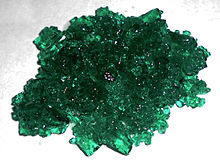Nickel nitrate is the inorganic compound Ni(NO3)2 or any hydrate thereof. In the hexahydrate, the nitrate anions are not bonded to nickel. Other hydrates have also been reported: Ni(NO3)2.9H2O, Ni(NO3)2.4H2O, and Ni(NO3)2.2H2O.[3]

| |
 Hexahydrate
| |
| Names | |
|---|---|
| IUPAC name
Nickel(II) nitrate
| |
| Other names
Nickel nitrate
Nickelous nitrate Nitric acid, nickel(2+) salt | |
| Identifiers | |
| |
3D model (JSmol)
|
|
| ChemSpider | |
| ECHA InfoCard | 100.032.774 |
| EC Number |
|
PubChem CID
|
|
| UNII | |
| UN number | 2725 |
CompTox Dashboard (EPA)
|
|
| |
| |
| Properties | |
| Ni(NO3)2 | |
| Molar mass | 182.703 g/mol (anhydrous) 290.79 g/mol (hexahydrate) |
| Appearance | emerald green hygroscopic solid |
| Odor | odorless |
| Density | 2.05 g/cm3 (hexahydrate) |
| Melting point | 56.7 °C (134.1 °F; 329.8 K) (hexahydrate) |
| Boiling point | 120–145 °C (248–293 °F; 393–418 K) (hexahydrate, decomposes to basic nickel nitrate)[1] |
| 243 (hexahydrate) g/100ml (0 °C)[2] | |
| Solubility | soluble in ethanol |
| +4300.0·10−6 cm3/mol (+6 H2O) | |
Refractive index (nD)
|
1.422 (hexahydrate) |
| Structure | |
| monoclinic (hexahydrate) | |
| Hazards | |
| GHS labelling: | |
    
| |
| Danger | |
| H272, H302, H315, H317, H318, H332, H334, H341, H350, H360, H372, H410 | |
| P201, P202, P210, P220, P221, P260, P261, P264, P270, P271, P272, P273, P280, P281, P285, P301+P312, P302+P352, P304+P312, P304+P340, P304+P341, P305+P351+P338, P308+P313, P310, P312, P314, P321, P330, P332+P313, P333+P313, P342+P311, P362, P363, P370+P378, P391, P405, P501 | |
| NFPA 704 (fire diamond) | |
| Flash point | Non-flammable |
| Lethal dose or concentration (LD, LC): | |
LD50 (median dose)
|
1620 mg/kg (oral, rat) |
| Safety data sheet (SDS) | External MSDS |
| Related compounds | |
Other anions
|
Nickel(II) sulfate Nickel(II) chloride |
Other cations
|
Palladium(II) nitrate |
Related compounds
|
Cobalt(II) nitrate Copper(II) nitrate |
Except where otherwise noted, data are given for materials in their standard state (at 25 °C [77 °F], 100 kPa).
| |
It is prepared by the reaction of nickel oxide with nitric acid:
- NiO + 2 HNO3 + 5 H2O → Ni(NO3)2.6H2O
The anhydrous nickel nitrate is typically not prepared by heating the hydrates. Rather it is generated by the reaction of hydrates with dinitrogen pentoxide or of nickel carbonyl with dinitrogen tetroxide:[3]
- Ni(CO)4 + 2 N2O4 → Ni(NO3)2 + 2 NO + 4 CO
The hydrated nitrate is often used as a precursor to supported nickel catalysts.[3]
Structure
editNickel(II) compounds with oxygenated ligands often feature octahedral coordination geometry. Two polymorphs of the tetrahydrate Ni(NO3)2.4H2O have been crystallized. In one the monodentate nitrate ligands are trans[4] while in the other they are cis.[5]
Reactions and uses
editNickel(II) nitrate is primarily used in electrotyping and electroplating of metallic nickel.
In heterogeneous catalysis, nickel(II) nitrate is used to impregnate alumina. Pyrolysis of the resulting material gives forms of Raney nickel and Urushibara nickel.[6] In homogeneous catalysis, the hexahydrate is a precatalyst for cross coupling reactions.[7]
References
edit- ^ Pietsch, E. H. E. (1966). Gmelins Handbuch der Anorganischen Chemie, Nickel Teil B 2 (in German) (8th ed.). Weinheim/Bergstr.: Verlag Chemie GmbH. p. 509.
- ^ Perry's Chem Eng Handbook, 7th Ed
- ^ a b c Lascelles, Keith; Morgan, Lindsay G.; Nicholls, David; Beyersmann, Detmar (2005). "Nickel Compounds". Ullmann's Encyclopedia of Industrial Chemistry. Weinheim: Wiley-VCH. doi:10.1002/14356007.a17_235.pub2. ISBN 3527306730.
- ^ Morosin, B.; Haseda, T. (1979). "Crystal Structure of the β Form of Ni(NO3)2.4H2O". Acta Crystallographica Section B: Structural Crystallography and Crystal Chemistry. 35 (12): 2856–2858. doi:10.1107/S0567740879010827.
- ^ Gallezot, P.; Weigel, D.; Prettre, M. (1967). "Structure du Nitrate de Nickel Tétrahydraté". Acta Crystallographica. 22 (5): 699–705. Bibcode:1967AcCry..22..699G. doi:10.1107/S0365110X67001392.
- ^ Sarko, Christopher R.; Dimare, Marcello; Yus, Miguel; Alonso, Francisco (2014). "Nickel Catalysts (Heterogeneous)". Encyclopedia of Reagents for Organic Synthesis. pp. 1–8. doi:10.1002/047084289X.rn011.pub2. ISBN 978-0-470-84289-8.
- ^ Xiao, Yu-Lan; Zhang, Xingang (2017). "Nickel(II) Nitrate Hexahydrate". Encyclopedia of Reagents for Organic Synthesis. pp. 1–3. doi:10.1002/047084289X.rn02013. ISBN 978-0-470-84289-8.
